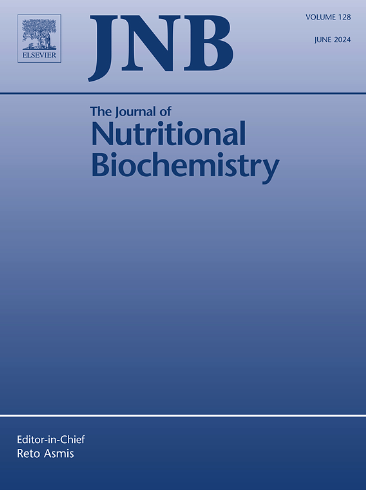模拟等热量宏量营养素替代如何与治疗后 12 个月内结直肠癌幸存者的血浆犬尿氨酸纵向相关。
IF 4.9
2区 医学
Q1 BIOCHEMISTRY & MOLECULAR BIOLOGY
引用次数: 0
摘要
几种宏量营养素的饮食摄入与结直肠癌(CRC)后的血浆犬尿氨酸有关,犬尿氨酸与健康相关的结果有关。目前尚不清楚宏量营养素替代如何影响血浆犬尿氨酸,这可能与制定指南有关,通过饮食改变来改善结直肠癌后的生活质量。使用等热量替代模型,我们研究了用一种常量营养素替代另一种常量营养素与CRC幸存者血浆色氨酸、犬尿氨酸和犬尿氨酸比率的纵向关系。对247例I-III期结直肠癌幸存者在治疗后6周、6个月和12个月进行测量。采用7 d饮食记录法测定各组大剂量营养素摄入量,采用液相色谱/质谱联用法测定血浆犬尿氨酸。为了进行分析,我们使用带有错误发现率(FDR)的线性混合模型来调整多重测试。FDR调整后,用100 kcal/d的总蛋白质代替100 kcal/d的总碳水化合物,血浆中犬尿酸(KA)、黄尿酸(XA)浓度升高,犬尿酸/喹啉酸(KA/QA)比值升高。以100 kcal/d的总脂肪代替100 kcal/d的总碳水化合物能提高色氨酸浓度,提高KA/QA比,降低犬尿氨酸/色氨酸比(KTR)和羟犬尿氨酸比(HKr)。用100千卡/天的总蛋白质代替100千卡/天的总脂肪与较高的XA浓度相关。总之,等热量常量营养素替代,特别是用蛋白质或脂肪替代碳水化合物,在治疗后12个月的结直肠癌幸存者中具有较高的潜在有利犬尿氨酸浓度和比率(即KA, XA和KA/QA比率)和较低的促炎或神经毒性比率(即KTR和HKr)。本文章由计算机程序翻译,如有差异,请以英文原文为准。

Modeling how iso-caloric macronutrient substitutions are longitudinally associated with plasma kynurenines in colorectal cancer survivors up to 12 months post-treatment
Dietary intake of several macronutrients is associated with plasma kynurenines after colorectal cancer (CRC), and kynurenines have been linked to health-related outcomes. It is unknown how macronutrient substitution affects plasma kynurenines, which may be relevant for developing guidelines to improve post-CRC quality of life through dietary changes. Using iso-caloric substitution models, we investigated how substituting one macronutrient with another is longitudinally associated with plasma tryptophan, kynurenines, and kynurenine ratios in CRC survivors. Measurements were performed at 6-weeks, 6-months, and 12-months post-treatment in 247 stage I–III CRC survivors. Macronutrient intake was measured by 7-d dietary records and plasma kynurenines by LC/MS-MS. For analysis, we applied linear mixed models with false discovery rate (FDR) to adjust for multiple testing. After FDR adjustment, substituting 100 kcal/d of total carbohydrates with 100 kcal/d of total protein was associated with higher plasma concentrations of kynurenic acid (KA), xanthurenic acid (XA), and a higher kynurenic acid-to-quinolinic acid (KA/QA) ratio. Substituting 100 kcal/d of total carbohydrates with 100 kcal/d of total fat was associated with higher tryptophan concentrations, higher KA/QA ratio, and a lower kynurenine-to-tryptophan ratio (KTR) and hydroxykynurenine ratio (HKr). Substituting 100 kcal/d of total fat with 100 kcal/d of total protein was associated with higher XA concentrations. Altogether, iso-caloric macronutrient substitutions, particularly substituting carbohydrates with protein or fat, were longitudinally associated with higher concentrations of potentially favourable kynurenines and ratios (i.e., KA, XA, and KA/QA ratio) and lower ratios with pro-inflammatory or neurotoxic properties (i.e., KTR and HKr) in CRC survivors up to 12-months post-treatment.
求助全文
通过发布文献求助,成功后即可免费获取论文全文。
去求助
来源期刊

Journal of Nutritional Biochemistry
医学-生化与分子生物学
CiteScore
9.50
自引率
3.60%
发文量
237
审稿时长
68 days
期刊介绍:
Devoted to advancements in nutritional sciences, The Journal of Nutritional Biochemistry presents experimental nutrition research as it relates to: biochemistry, molecular biology, toxicology, or physiology.
Rigorous reviews by an international editorial board of distinguished scientists ensure publication of the most current and key research being conducted in nutrition at the cellular, animal and human level. In addition to its monthly features of critical reviews and research articles, The Journal of Nutritional Biochemistry also periodically publishes emerging issues, experimental methods, and other types of articles.
 求助内容:
求助内容: 应助结果提醒方式:
应助结果提醒方式:


